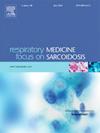Exploring sleep-related breathing disorders in pediatric obesity and Prader-Willi syndrome
IF 3.5
3区 医学
Q2 CARDIAC & CARDIOVASCULAR SYSTEMS
引用次数: 0
Abstract
Objective
To analyze the differences of clinical and diagnostic features of sleep related breathing disorders (SRBDs) between children with PWS and obese children, considering obesity as a unifying risk factor for sleep apnea.
Study design
This retrospective cohort study included ≥2 years of age children who had obesity and genetically confirmed Prader-Willi syndrome (PWS) or were non-PWS obese children. Out of 267 children, 58 children met inclusion criteria. Clinical data and records of standard overnight polysomnography (PSG) were collected and compared between groups during the study.
Results
Obstructive sleep apnea (OSA) was identified in 97.2 % non-PWS obese children and 72.7 % PWS children (p = 0.072). Central sleep apnea (CSA) events were more commonly found in children with PWS (p = 0.035, OR 4.35, CI 95 % 1.05–18.03) as well as sleep-related hypoventilation (p = 0.016, OR 4.66, CI 95 % 1.26–17.34). Sleep efficiency was higher in PWS patients (p = 0.038). Sleep fragmentation was significantly associated with higher AHI only in non-PWS obese children (p = 0.027). In the PWS group patients, a moderate correlation was found between BMI and age (p = 0.025, r = 0.559, CI 95 % 0.087–0.826) as well as AHI and age (p = 0.003, r = 0.686, CI 95 % 0.232–0.895).
Conclusions
Non-PWS obese children, similar to those with PWS, exhibit a high risk of SRBDs. Although CSA and sleep-related hypoventilation may occur more frequently in patients with PWS, OSA remains the predominant disorder. Both patient groups are advised to undergo PSG due to the significant risk of SRBDs, particularly during adolescence.
探索小儿肥胖症和普拉德-威利综合征中与睡眠相关的呼吸紊乱。
目的考虑到肥胖是睡眠呼吸暂停的一个统一风险因素,分析普氏综合征儿童和肥胖儿童睡眠相关呼吸紊乱(SRBD)的临床和诊断特征的差异:这项回顾性队列研究包括年龄≥2岁的肥胖儿童和经基因证实患有普拉德-威利综合征(PWS)的儿童或非普拉德-威利综合征肥胖儿童。在267名儿童中,有58名符合纳入标准。研究期间收集了临床数据和标准夜间多导睡眠图(PSG)记录,并对各组进行了比较:结果:97.2%的非PWS肥胖儿童和72.7%的PWS肥胖儿童患有阻塞性睡眠呼吸暂停(OSA)(P = 0.072)。中枢性睡眠呼吸暂停(CSA)事件在PWS患儿中更常见(p = 0.035,OR 4.35,CI 95 % 1.05-18.03),睡眠相关通气不足(p = 0.016,OR 4.66,CI 95 % 1.26-17.34)也更常见。PWS患者的睡眠效率更高(p = 0.038)。只有非PWS肥胖儿童的睡眠片段与较高的AHI明显相关(p = 0.027)。在PWS组患者中,BMI与年龄(p = 0.025,r = 0.559,CI 95 % 0.087-0.826)以及AHI与年龄(p = 0.003,r = 0.686,CI 95 % 0.232-0.895)之间存在中度相关性:结论:非PWS肥胖儿童与PWS肥胖儿童相似,都表现出较高的SRBD风险。虽然CSA和睡眠相关通气不足在PWS患者中发生的频率更高,但OSA仍是主要的疾病。由于 SRBD 的风险很大,尤其是在青春期,因此建议这两类患者都接受 PSG 检查。
本文章由计算机程序翻译,如有差异,请以英文原文为准。
求助全文
约1分钟内获得全文
求助全文
来源期刊

Respiratory medicine
医学-呼吸系统
CiteScore
7.50
自引率
0.00%
发文量
199
审稿时长
38 days
期刊介绍:
Respiratory Medicine is an internationally-renowned journal devoted to the rapid publication of clinically-relevant respiratory medicine research. It combines cutting-edge original research with state-of-the-art reviews dealing with all aspects of respiratory diseases and therapeutic interventions. Topics include adult and paediatric medicine, epidemiology, immunology and cell biology, physiology, occupational disorders, and the role of allergens and pollutants.
Respiratory Medicine is increasingly the journal of choice for publication of phased trial work, commenting on effectiveness, dosage and methods of action.
 求助内容:
求助内容: 应助结果提醒方式:
应助结果提醒方式:


